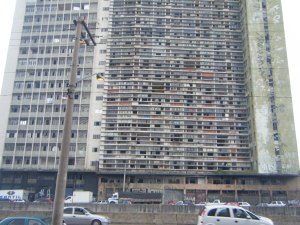
*The law working against the people
Ok. So bear with me for this is my first attempt at blogging. This is a picture of two building that have been cleared out by the city of Sao Paulo. They are an example of the government clearing out space in the city (space previously occupied by lower-middle-class people) to build a park and a parking lot for an area they are trying to gentrify and bring in private investment. Meanwhile, I visited the building on the left on a Manday. There were about 35 families still living there, and the story that they told was that the city bought out their apartments (which most families were leasing) and essentially turned a few hundred people living in a building legally into squatters. The Security was tight to enter the building, there were no fire extinguishers, no maintenence of the elevator, and many of the apartments are sealed off. It’s aweful. When we went, we talked to the community organizer for the building and he said they were in negotiations with city hall to find new apartments in the dowtown area. On wednesday we heard that all 35 families (about 120 people) were evicted. They were essentially thrown out into the street.
It will be interesting to come to this same area (it is right next to the municipal market in Sao Paulo) in a few years and see what the follow through has been with whatever the city has planned for this area.
